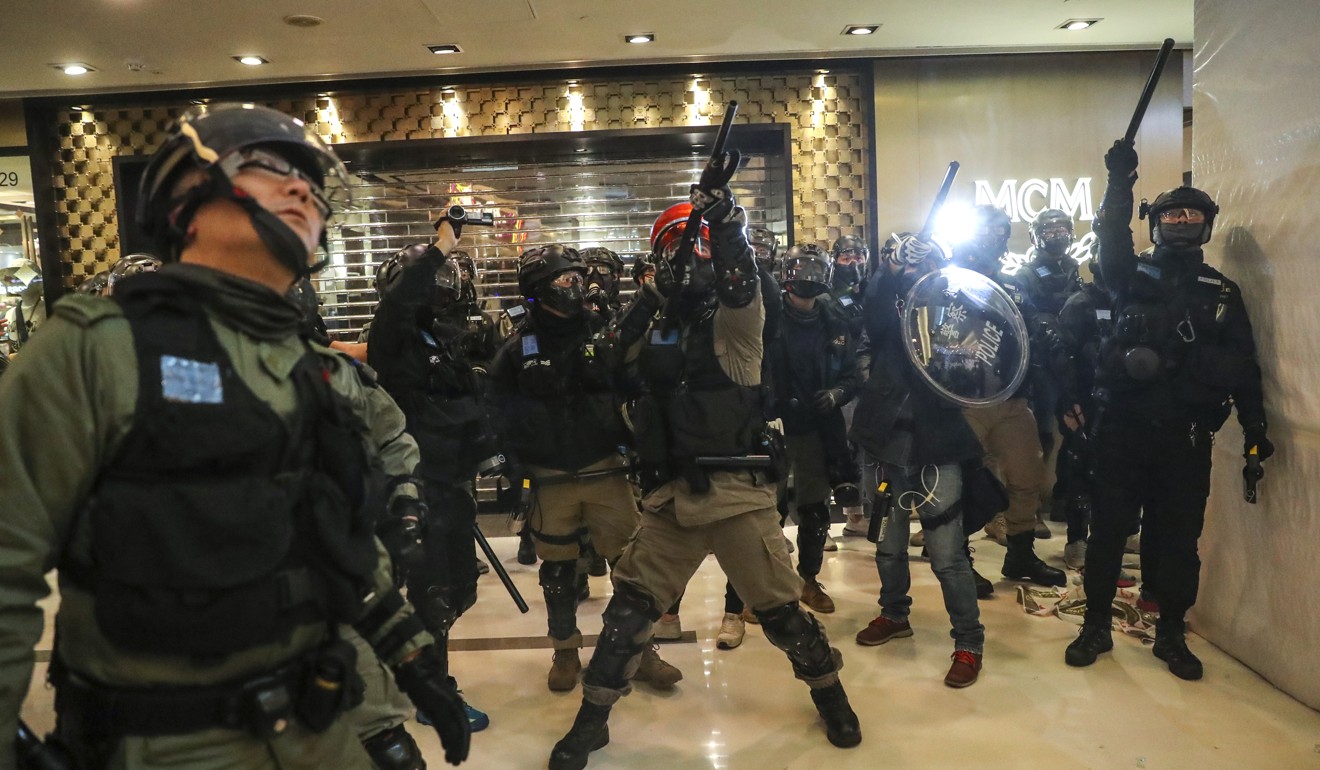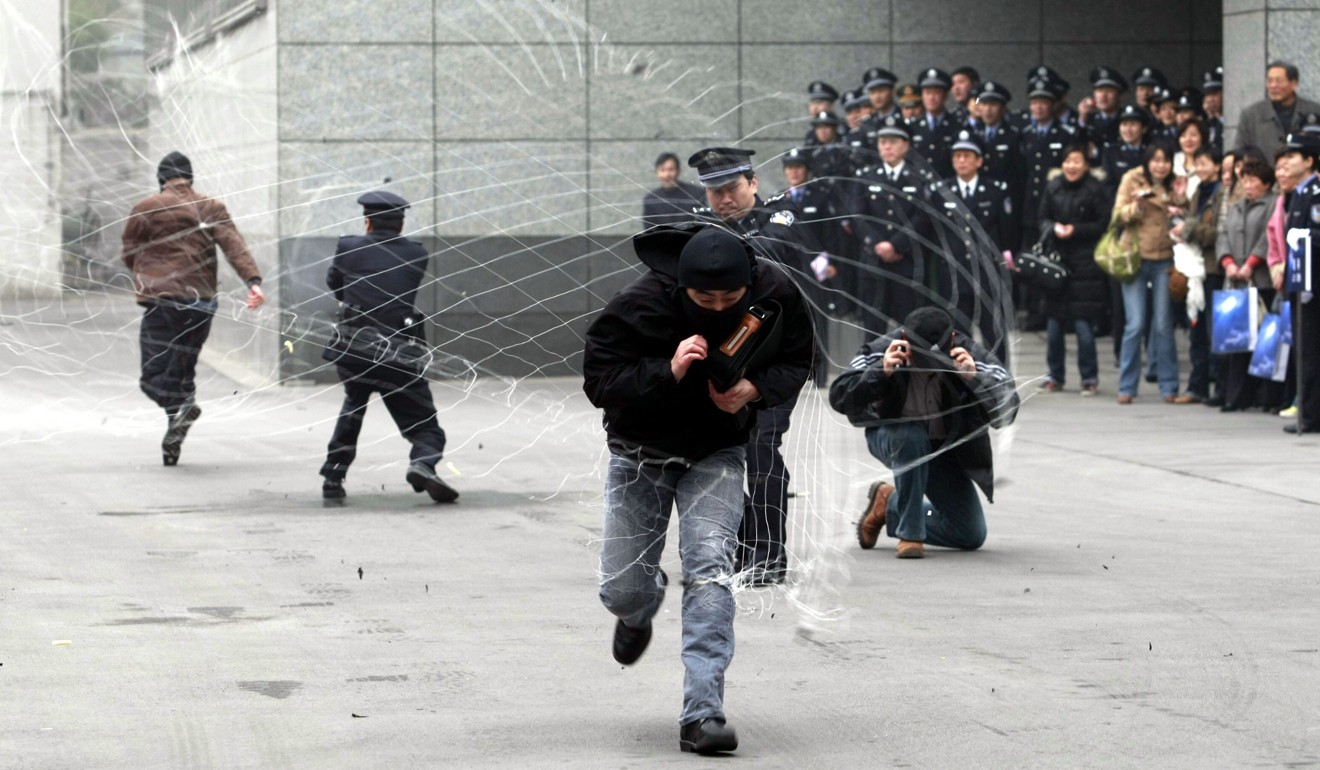
Exclusive | Hong Kong police consider arming officers with electroshock devices and net guns amid protests
- Stun guns and other electroshock weapons assessed by force chiefs for frontline policing, security minister backs review
- Safety fears raised over their potential deployment, which would come with city in grip of anti-government demonstrations
Police are looking at arming officers with weapons that stun suspects or entangle them in nets in a move that would bolster their response to protests in Hong Kong, the Post has learned.
Security experts and rank-and-file officers said the plan would help plug gaps in the force’s arsenal and provide safer alternative to firearms, but human rights groups warned of the health risks, such as cardiac arrest.
A senior police source said they had been comparing different models of electroshock devices and net guns available on the market.

“The purpose is to enrich the use-of-force options, instead of increasing the force level or bringing in lethal weapons,” the source told the Post.
“It benefits both officers and suspects, as the longer the suspect resists or struggles [during arrest], the higher the chance we both get hurt.”
On Wednesday, Secretary for Security John Lee Ka-chiu did not deny electroshock devices were being considered for deployment, when asked by a lawmaker in a Legislative Council meeting.
“Police will take appropriate force against any illegal acts, and the Security Bureau supports any method to better enable the force to deal with violence while reducing casualties,” Lee said.
“Any equipment being studied by police are already in use by [police] forces in foreign countries and have a good track record in reducing casualties. These studies are ongoing.”
The exploration of new hardware comes after police reviewed Operation Tiderider, which was launched in June last year to deal with street protests.
A guide to weapons police use on extradition bill protesters
Masked radicals in the movement have trashed railway stations and businesses with links to mainland China, occupied the airport and universities, and set roadblocks on major thoroughfares.
The police source, who said they would consider any tools for effective arrests, added many suspects continued to fight back when being apprehended, leading officers to respond with batons and pepper spray, which the source said had triggered accusations of brutality.
Since June, police have fired more than 16,000 rounds of tear gas, 10,000 rubber bullets, 2,000 beanbag rounds and 19 live rounds.
Tasers and stun guns – devices that deliver a modulated electric current designed to disrupt voluntary control of muscles – are used by law enforcers overseas, including those in the United States, Britain, Australia and Singapore. American, Japanese and Taiwanese police are also equipped with net guns, which release material to entangle the target.
Legal test for warrants that let Hong Kong police search phones
The Post was told that Hong Kong police tested stun devices in the wake of the Mong Kok riot in 2016, when hundreds went on a rampage on the first night of Lunar New Year after a crackdown on illegal food hawkers.
But the force then did not take the idea forward due to health and political concerns. The proposal resurfaced recently alongside deterioration in the social situation.
Chairman of the Junior Police Officers’ Association, Lam Chi-wai, welcomed any weapons that helped increase the distance between police and suspects, as he said officers were “having brushes with death” when “dealing with the mobs”.
“These weapons are less lethal and the effects on suspects are temporary. If they were adopted along appropriate tactics and guidelines, I believe they can boost the force’s capability to curb violence,” Lam said.
According to data collected by Amnesty International, at least 500 people in the US died between 2001 and 2012 after being tasered during arrest or while in custody.
The group has called for tighter restrictions on such weapons, adding they should only be used in situations where police would otherwise consider using firearms.
Hong Kong protesters got training from foreign forces, security chief says
Another police insider said the force would study and test the side effects before adopting any new weapon. “The effectiveness of pepper spray has decreased as protesters now have better protective gear,” he said.
“Every tool, including batons, can kill if wrongly used. But stun devices are mainstream and less lethal. Figures tell us that only 13 out of one million individuals could die from or be severely injured by stun devices.
“Its level of force is even below pepper spray in America.”
But the source admitted arming officers with net guns was “less likely” because initial investigation had found it was not easy to trap a particular target in a crowd.

Security consultant and former police superintendent Clement Lai Ka-chi, who helped set up the force’s counterterrorism response unit, said even private security officers used stun devices, because the temporary electroshock could avoid physical confrontations between police and suspects.
He added the new range would introduce choice at levels between pepper spray, tear gas and firearms, whereas using net guns could help stop suspects from hurling petrol bombs, for example.
“Being Asia’s finest is not only about police performance, but also the choice of equipment. The new weapons help prevent the loss of lives,” Lai said.
“Officers can choose not to fire a warning shot in a violent situation.”
Despite the benefits, Lai said using stun guns might bring unexpected consequences when used on suspects with hidden health conditions.
Hong Kong Human Rights Monitor director Law Yuk-kai said the new equipment was “unnecessary” because police had enough options to handle suspects and warned that electroshock could endanger the lives of those suffering from chronic heart disease.

Law said the devices would make it easier for police to “mask their brutality”, adding: “People can still count the times [officers] hit a suspect with a baton.
“But if a taser is in use, you can’t tell if a suspect has suffered because of the electroshock or of the physical confrontation.”
A police spokesman said the force had been considering the sourcing and procurement of various equipment to enhance operational efficiency.
“Details of the procurement will not be disclosed due to operational considerations,” he said.

